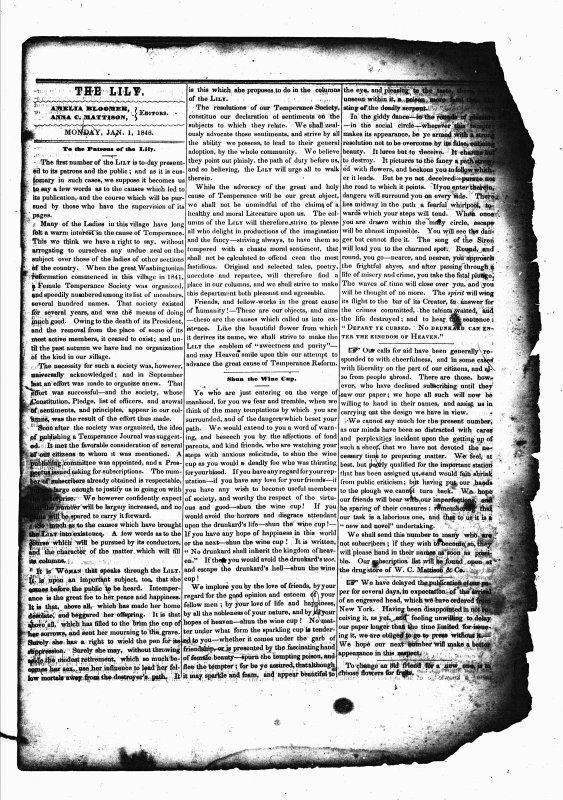 | ||
Founded 1 January 1849 (1849-01-01) Political alignment Temperance and Women's Rights | ||
The Lily, the first U.S. newspaper edited by and for women, was published from 1849 to 1853 by Amelia Jenks Bloomer (1818–1894). She sold the newspaper to Mary Birdsall in 1854. While the newspaper was initially focused on temperance, the focus was soon broadened to the many issues of women’s rights activists in the 1850s.
Contents
First issues
Initially the title page had the legend "Published by a committee of ladies." The inaugural issue, January 1, 1849, sets forth the philosophy and initial goals: "It is WOMAN that speaks through the LILY. It is upon an important subject, too, that she comes before the public to be heard. Intemperance is the great foe to her peace and happiness." Amelia Bloomer's initial interest was not in women's rights but in temperance and it was not her choice that it became her newspaper. However the committee that originally proposed it lost interest and Bloomer felt that if she did not manage the paper then observers would assume that it had foundered because it was run by women.
By 1850 the Lily was describing itself as "DEVOTED TO THE INTERESTS OF WOMEN" and by 1852 as dedicated to "Emancipation of Woman from Intemperance, Injustice, Prejudice, and Bigotry.' Bloomers' involving of many editors and contributors helping one another became a model for later periodicals focused on women's suffrage. Other early periodicals edited by women and focused on women's issues and protests include The Genius of Liberty (1851–1853), edited by Elizabeth Aldrich; The Pioneer and Woman's Advocate (1852–1853), edited by Ann W. Spencer; The Una (1853–1855), edited by Paula Wright Davis; The Revolution (1868–1872), edited by Susan B. Anthony, Elizabeth Cady Stanton, and Parker Pillsbury; The Woman's Advocate, (1855–1858), and The Sibyl (1856–1864), edited by Lydia Hasbrouck. Bloomer herself wrote: "The Lily was the first paper devoted to the interests of woman and, so far as I know, the first one owned, edited and published by a woman." The first issues were priced at 50 cents a year and published in Seneca Falls, New York.
Later issues
Increasingly in the early 1850s, the relationship of the temperance movement and the women's struggle for suffrage became more pronounced in the Lily. Elizabeth Cady Stanton, a contributor, demanded in an article that women be included in the making of laws to restrict liquor sales, and to divorce intemperate men. Bloomer wrote that "the only way in which women can do anything effectually in this [temperance] cause is through the ballot-box", a position she called "a strong women's rights sentiment." The Lily carried articles not only on women's suffrage but also on major social reform issues such as property rights, education, employment, dress reform, and slavery, including women's slavery to men. In a biography of Amelia Bloomer written by her husband, she is quoted as declaring that she never liked the "pretty" name of the paper (appointed by the local women's temperance society) but since the newspaper soon became known far and wide by that name, she decided not to change it. The Lily rose from a circulation of 500 a month to 4000 a month, with some of the increase because of the dress reform controversy.
1854
In 1854 Amelia Bloomer sold the paper to Mary Birdsall because she was moving house. Bloomer continued as a corresponding editor. Birdsall had been an editor of the Indiana Farmer and in particular its women section. She was a supporter of Bloomer's views and the newspaper provided a vehicle for her to continue her journalism. The newspaper continued to campaign for women's issues and temperance. It was published in Richmond, Indiana for some years and was distributed nationally.
